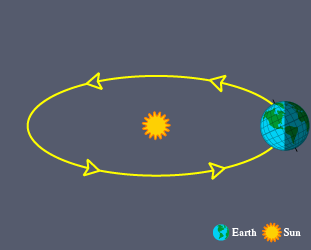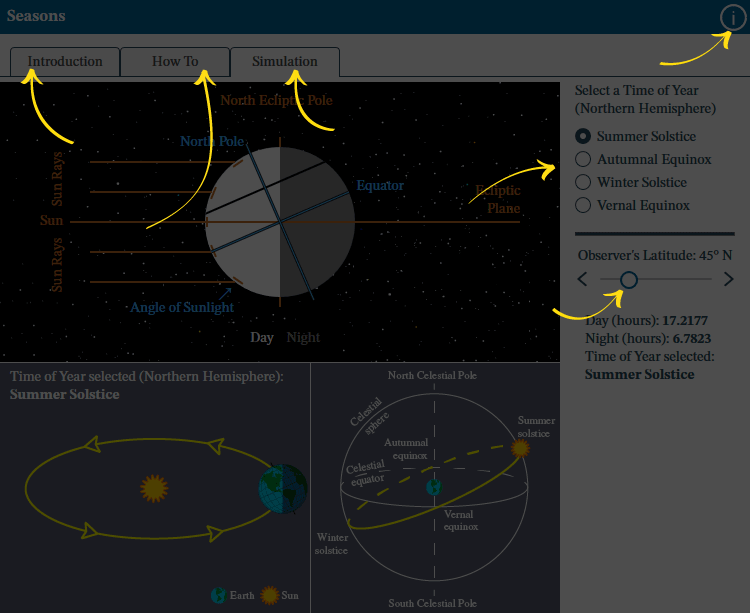We are all impacted by the seasons. In going from winter to summer, we see the Sun appear higher and higher in the daytime sky, we see the days (daylight) grow longer, and we also find the days are hotter. Then, the reverse occurs going from summer solstice to the winter solstice. In this interactive, we explore how these phenomena occur. There are three main factors that create these effects:
- the position of Earth in its orbit
- the 23.5 degree tilt of Earth’s axis
- the latitude of the observer
Why does Earth’s tilt matter? During summer in the Northern Hemisphere, the North Pole is tilted toward the Sun and this causes the Sun to appear higher in the sky and above the horizon for longer, meaning the nights are shorter. The days are hotter because the Sun has more time to heat the surface and the higher the Sun is in the sky, the more direct the angle of its rays, so it is more effective at heating.
Try selecting an equinox as the Earth’s orbital position using the simulation. Use the latitude slider to see that if you were standing at either the North or South pole the Sun would be on your horizon—a very shallow angle. At the equator, it could pass straight overhead—a 90 degree angle. What do you notice about the length of day and night at different latitudes?
If you select a solstice, you can see either the North or the South hemisphere is tilted towards the Sun and is experiencing summer, while the other is tilted away and experiencing winter. During a solstice, the amount of day and night changes dramatically with latitude; one pole experiences 24 hours of daylight (the land of the midnight sun) while the other never sees the Sun rise. It is the Earth’s tilt that determines how extensive the regions of all daylight or all nighttime are, and they are called the Arctic (within 23.5 deg of the North Pole, i.e. north of 66.5 deg) and Antarctic (south of 66.5 deg) zones for the North and South poles respectively.
Note the Equator, because of symmetry, always sees 12 hours of day and 12 hours of night!
What would happen if the Earth’s tilt was 0 degrees? What about a tilt of 90 degrees?
Not shown in this interactive: Because Earth’s orbit is very circular, the distance from the Sun only has a small influence on the temperature at different times of year, but it is enough to cause summers in the Southern Hemisphere to be slightly hotter than those in the Northern Hemisphere.
Your goal is to explore how the time of year and the tilt of the Earth’s axis vs. its orbit (the ecliptic plane) create seasonal differences based on latitude. At the top of the main view, compare the length of day and night and the angle at which the Sun’s rays hit the Earth at different latitudes and times of year. In the lower left, explore Earth’s tilt in relation to its orbit around the Sun at your chosen time of year. In the lower right, observe the position of the Sun along the ecliptic on the Celestial Sphere at your chosen equinox or solstice.
There are two control options.
- Choose a Time of Year, based on the Northern Hemisphere: either an equinox or solstice.
- Adjust the Latitude at which to observe the length of day and night. This control only impacts the Length of Day view at the top.
Note: The seasons are reversed in the Southern Hemisphere. Viewing this simulation’s Winter Solstice shows the Southern Hemisphere’s Summer Solstice, etc.
Your goal is to explore how the time of year and tilt of the Earth on its axis impacts daylight and the angle of the Sun at different latitudes.
This simulation is divided into 3 regions: First, the title banner with the info button. Second, the navigation options. Third, the controls region where you can set the latitude and choose the time of year then compare the length of day and night at different latitudes and get a description of your chosen time of year from three distinct views. Visit the How To tab for details.
Summer Solstice (Northern Hemisphere) in Three Views
Length of Day View
- Earth’s North Pole is tilted toward the Sun, falling between the Sun and the line between the North and South Ecliptic Poles that divide day from night (Ecliptic polar axis).
- The angle between Earth’s polar axis and the Ecliptic polar axis translates into extra daylight for the Northern Hemisphere. The farther north the latitude of the observer, the greater the distance between the axes and the more extra daylight.
- The equator is tilted so that its Western half lies below the Ecliptic Plane of the Sun and its Eastern half lies above the Ecliptic Plane.
- Four lines cross at the same point in the center of Earth: the equator, the line between Earth’s North and South poles, the Ecliptic Plane, and the line between the North and South Ecliptic poles.
Earth’s Orbit View
Earth is at the far right of its counterclockwise orbit around the Sun. The North Pole is tilted toward the Sun and the South Pole is tilted away from the Sun. The day/night line runs vertically. In this depiction, North America and Greenland are in daylight while South America and parts of Europe and Africa are in darkness.
Celestial Sphere View
At Summer Solstice the Sun’s apparent orbit brings it above the Celestial Equator—in the northern celestial hemisphere—and to the East.General description of the celestial sphere: Imagine a celestial sphere surrounding Earth with the North Celestial Pole at the top and the South Celestial Pole at the bottom. The celestial equator, then, is a line circling the celestial sphere, aligned with Earth’s equator. The Sun appears to travel in a line that also circles the celestial sphere, but tilted at an angle compared to the celestial equator.
Information: Reopen this overview screen.
Introduction tab contains background information about the subject of the simulation.
How To tab contains detailed information about how to use the simulation.
Simulation tab contains the simulation.
Select a Time of Year: Choose a time of year to observe in the Northern Hemisphere.
Observer's Latitude: Adjust the value using the left and right arrows or by dragging the circle.



